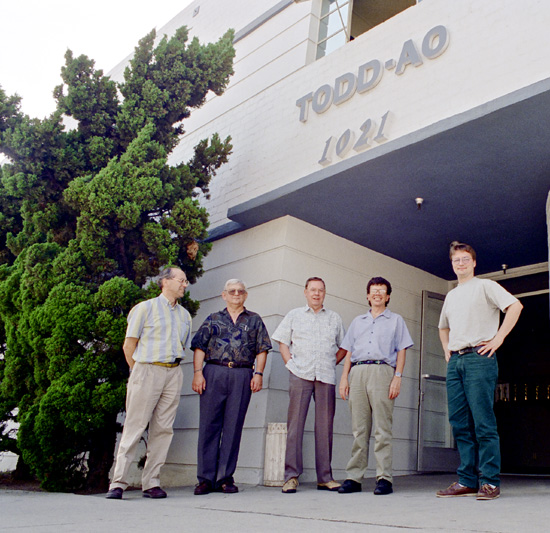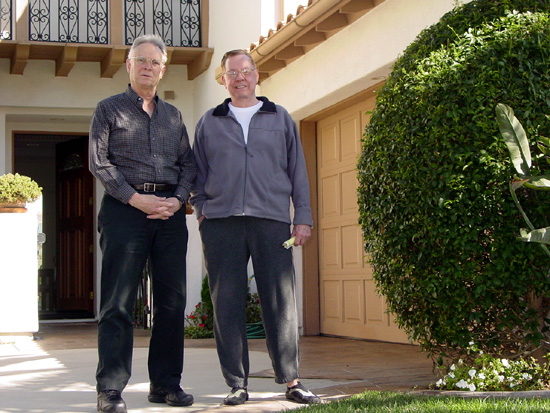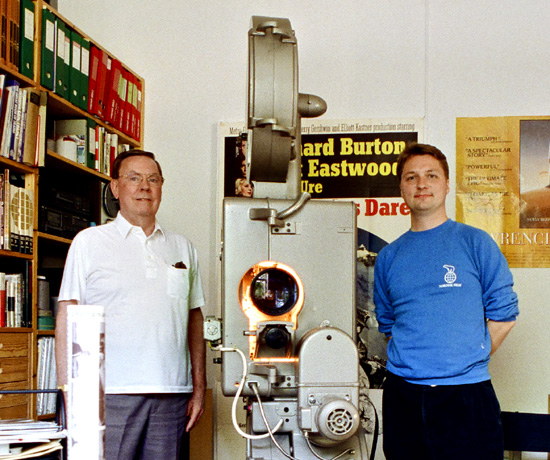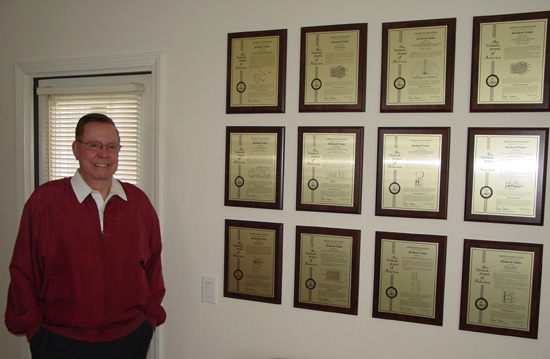Richard Vetter Passed Away |
Read more at in70mm.com The 70mm Newsletter |
| Written by: Robert Weisgerber | Date: 02.11.2015 |
 The
70mm Promotion Tour, 1994 outside the Todd-AO Studios in 1021 North Seward
Street, Los Angeles. Left: Johan Wolthuis, Dan Leimeter, Richard Vetter,
Darryl Grey and Thomas Hauerslev The
70mm Promotion Tour, 1994 outside the Todd-AO Studios in 1021 North Seward
Street, Los Angeles. Left: Johan Wolthuis, Dan Leimeter, Richard Vetter,
Darryl Grey and Thomas HauerslevI first met Dick in 1965 at the newly built LeFrak City UA Theater in Queens New York. I had just graduated from high school. I got preview tickets for the introduction of Dimension-150 the first all purpose-multi format movie theater in the world. Not knowing what this was all about a friend of mine and I went to the press event the day before the theater was to have its grand opening. The theater was not fully completed and one of the items still to be installed was the projection port glass. Sitting in the auditorium as the demonstration was about to change from conventional 70mm to D-150 and as the masking opened to the format I heard the projector running at a faster speed than the prior formats and wondered why? Following the presentation we were invited into the projection room and the men in there were happy that the press presentation went off without hitch, they had big smiles on their faces. The men introduced themselves to us and they were Carl Williams, Joe Kelly and Dick Vetter along with two operators. I asked at one point why the D-150 footage required the projector to run faster, I assumed it was 30fps as "Oklahoma" and "Around The World In 80 Days" had been presented years earlier. Dick turned to me and asked how I knew it was at a faster projection speed and I responded I could hear the projectors from the rear of the auditorium due to the lack of the port glass. Dick made a note of it! Dick then excused himself and we did not meet again until the 80's. As I found out years later from Joe Kelly the most difficult part of the Lefrak install was the screen. When the screen arrived from Harkness they tried to get it through the side entrance and the angle of entry was not wide enough. Joe had to have the building contractor come back quickly, remove the door as well as several feet of brick wall to allow the screen to get in. Fast forward two decades later, I rented an AP-65 hand held 5 perf Todd-AO camera for some test footage I was going to have shot. The camera was fitted with a 1.5 vertical squeeze anamorphic lenses for my FuturVision - 360 process that was the equivalent of a Mini-Imax 1.43:1 format. I was going to market it for the conventional cinema versus purpose built theaters for the Imax 15 perf format. Once again, by chance I met Dick, this time at his Todd-AO offices on Sunset Blvd. in LA. He was very helpful in me on how to best retrofit the lens to the camera etc, but I never mentioned to him at that time that we had met in the 60's at Lefrak and would leave that conversation for two more decades later. |
More in 70mm reading: Motion pictures photographed in Dimension 150 Visual Display for U.C.L.A. Driving Simulator: Dimension 150, Introduction The D-150 Curvulon Lens Full credits for "CineSpace 70" Carl W. Williams Passed Away The 70mm Promotion Tour 1994 Internet link: Richard Vetter |
 Paul
Rayton and Richard Vetter in his home in Carlsbad, California, in February
2006 Paul
Rayton and Richard Vetter in his home in Carlsbad, California, in February
2006Around 2005 I again met Dick in Hollywood where I was renting a theater to showcase 70mm, 48 frame photography and projection. It was marketed as SDS-70 and Dick came to a screening to see what it was all about. When the presentation was completed I met Dick in the lobby and he was all enthused about what I had done and offered his support in whatever way he could. Dick by this time was no longer working for UA Theaters and Todd-AO but was working on several new cinema innovations on his own. We met several times for lunch going over the trial and tribulations of introducing new technology to Hollywood. We spent dozens of hours on the phone exchanging information on cinema technology, especially the cinema digital revolution. Dick opened up a lot to me and told me of one of his most disappointing events that happened to him while he was trying to close a big feature planned to be shot in Todd-AO. He told me he had lunch with Jack Warner president of Warner Bother's Studio to finalize a contract for Todd-AO to supply cameras and camera services for the big musical "My Fair Lady." When he left the meeting he was assured that it was a "go" and that paperwork should follow. Days later Dick got a call from Warners and they informed him that Panavision was going to be the supplier of 70mm cameras instead, Dick was astounded and greatly disappointed, he thought he had a deal with Jack Warner and there was nothing he could do about it. With all the trials and tribulations that Dick went through over the years in Hollywood he always believed firmly in the 70mm format and the value it brought to feature films, yesterday, today and tomorrow. He was extremely knowledgeable and was willing to share it all, but most importantly a true gentleman. We will all miss him! |
|
About Richard Vetter |
|
 Richard
Vetter and Thomas Hauerslev in 1994, during one of Richard's cruises. One of
which took him to Copenhagen, Denmark. Richard
Vetter and Thomas Hauerslev in 1994, during one of Richard's cruises. One of
which took him to Copenhagen, Denmark.February 24, 1928 - August 11, 2015 CARLSBAD - Richard H. Vetter (Dick) was born in San Diego in 1928 and educated in the local schools. After graduation from Hoover High School he enlisted in the Navy and was assigned to an intensive School of Photography in Pensacola, Florida, which furthered his motivation and fascination of the subject of photography. As a child he was already captivated with photography and especially motion picture magic. Following his brief service in the Navy he continued with his formal education at Pepperdine University receiving a Masters in Education and taught high school for a short while when he decided to pursue his PH.D. at UCLA in Audio Visual Studies and Theater Arts. Subsequently he was appointed Associate Professor at UCLA and taught there for several years where he invented a motion picture simulator having received a special grant from the Institute of Transportation and Traffic Engineering. This widescreen development caught the attention of Louis de Rochemont, a well-known documentary and dramatic producer, who introduced him to the executives of United Artists Theatres. Dr. Vetter eventually became Vice President of Research and Development for UA Theatres. Development of the driving simulator system into a theatrical technology for producing and releasing Hollywood's feature films resulted in the formation of a new subsidiary of United Artists named Dimension 150. This combination of using Todd-AO 65 mm cameras and D-150 optics was designed to compete with Cinerama, Panavision other widescreen formats that became premium venues during the 50's and 60's. |
|
 Richard
Vetter in his home in Carlsbad, California, in February 2006. Image by Paul
Rayton Richard
Vetter in his home in Carlsbad, California, in February 2006. Image by Paul
RaytonBy the mid 60's the production and exhibition hardware and software was an unprecedented success. Dick's patented technology was installed in over sixty D-150 systems in the U.S., Mexico, South America, Europe and the Far East. Following a demonstration of the D-150 system at the UA Egyptian Theater in Hollywood, Frank McCarthy, producer for 20th Century Fox and Franklin Schaffner, Director of "Patton", selected D-150. Photographer Fred Koenekamp received a well-deserved Academy Award Nomination for best photography along with Dr. Vetter's Dimension 150. Dick Vetter holds over 40 patents of which many are associated with the technology of wide-screen motion picture exhibition as well as other patents that resulted in improvements for the science of the motion picture industry. Dick Vetter was a proud voting member of the Academy of Motion Pictures Arts and Sciences and a member of the American Society of Cinematographers among many other such organizations. Dick enjoyed travelling with family and friends taking numerous cruises over the years along with his faithful participation in our many family celebrations. He was a devoted husband, truly dedicated to his wife, Elizabeth Storrow, who pre-deceased him in 1970. Both his brothers, George and Norman Vetter, also, predeceased him. He is survived by his two children, Catherine Vetter-Johnson and Rodney Vetter, his sister Gail Marshall (Phillip), sister-in-law L'roida Vetter along with his grandchildren, great-grandchildren, nieces, nephews and cousins. Dick was loyal, caring, humorous, fun-loving and generous with all of us who knew him best as well as being a significant contributor to various philanthropies and an icon in the motion picture industry. We will cherish the memories of the many years he so lovingly spent with us. Private memorial services and interment were held at Forest Lawn Memorial Park in Glendale. |
|
A conversation with Dr Richard Vetter about his early film days, UCLA, Dimension 150 and Joe Kelly |
|
|
In Feb. of 2006, Paul Rayton visited Dr.
Richard Vetter at the Vetter home in Carlsbad, California. In a free-ranging
and very casual interview, Mr. Rayton reminisced with Dr. Vetter about his
life history and experiences. Dr. Vetter had many patents issued to him over
his career, but he seemed proudest of the one for the 70mm process which was
called "Dimension
150", or D-150. |
|
| Go: back - top - back issues - news index Updated 21-01-24 |
